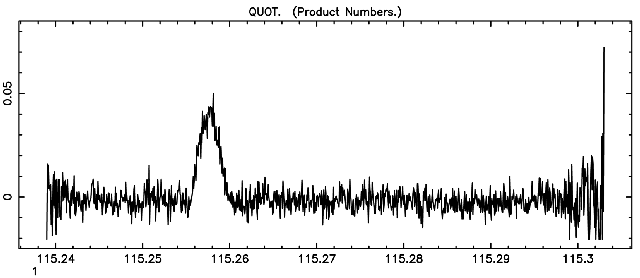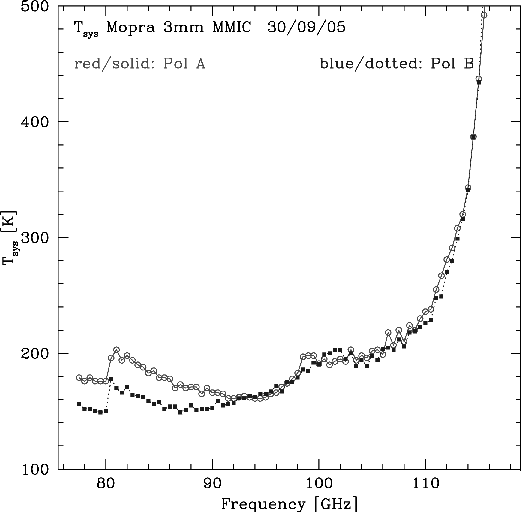Compact Array and Mopra report
Compact Array system developments
The first millimetre observing season (May October) for the new 3-mm receivers is nearly complete. Overall it has been very encouraging. The new systems performed very well, with a lowest system temperature of 150 K on one receiver at times. Observing at 3-mm wavelength is now routine, although it still requires the observer to be more attentive than for centimetre observing. During the winter a second set of 16-MHz filters was installed on the array, and is now a normal part of the observing system. There is now a broad understanding of some instrumental phase problems that hindered 3-mm projects in the past, and a workaround for these problems is being used. Problems with the pointing model, at the level of interest to 3-mm observers, are also broadly understood and partially resolved. Monitoring of the atmospheric sky brightness is now available through the MoniCA monitoring application and directly through the web. One shortcoming of this monitor is that it only sees the sky when the 3/12-mm receiver package is in use. A new lightning monitor has been installed.
One problem that has come to light over the winter is high system temperatures occurring in some 12-mm receivers. This can result from both condensation on the outside of the dewar window and from icing up within the dewar. Heaters have been placed on the feedhorns of the most problematic antennas, and this largely eliminates the condensation problem. A design modification to eliminate the icing is in hand, but will require opening all of the millimetre dewars to effect the change. Planning for the required work is in hand.
One less obvious achievement has been to eliminate the antenna control computer (ACC) crashes. Previously an ACC would crash every day or so. The crashes were traced to a hardware-related interaction within the ACC operating system, pSOS. Apart from some crashes after loading new control software on 7 and 8 September, there have been zero ACC crashes during observing since 16 July. Congratulations to those who have finally rid the Compact Array of this nuisance!
In other software news, the LINUX observing system is now quite complete and regularly used. In particular, it was used for two weeks in September as part of "split array" observing where the Compact Array was used at the same time for two different projects. However there remain some issues which mean that LINUX cannot yet be promoted to the normal observing system.
Mopra system developments

Figure 1: First light Mopra 3-mm MMIC receiver (Courtesy Juergen Ott and Michael Kesteven).
The millimetre season has been also highly successful for Mopra. In 2004 cryogenic problems plagued the SIS receiver. In 2005, apart from an early hiccup, these cryogenic problems have been resolved. The 600-MHz wide "POCS" backend (a proof of concept system for the full Mopra digital filterbank) was used for a set of observations. At the start of the season, the Mopra Lodge facilities received a facelift, with a new coat of paint, new carpet and some new furniture and fixtures.
However the highlight at Mopra came late in the millimetre season. A shutdown in September saw
the successful installation of a 16 – 26-GHz and 77 – 117-GHz MMIC receiver (see separate article on page 9);
associated upgrades to the cryogenics, primary monitoring, and system monitor and control hardware;
the switch-over to a LINUX-based observing system; and
the installation of a wideband IF system.
Performance after all the changes has been excellent (see Figure 1). To quote an observer: "the new system is a joy". The system temperature of the new receiver is at least as good as, and in many cases better than, the SIS system (see Figure 2). In addition it has a broader frequency range, broader instantaneously accessible bandwidth and requires no mechanical tuning. It is a lower maintenance and more robust system.

Figure 2: Mopra system temperature with the new 3-mm MMIC receiver (Courtesy Juergen Ott).
To cap off the season, the first 2-GHz segment of the Mopra digital filterbank MOPS was commissioned on 15 October, and was quickly put into use for routine observing. All those associated with all the Mopra upgrades can be deservedly proud of the results.
It is hoped the broadband network connection will be installed at Mopra around the end of the year.
Other developments
As noted in the previous newsletter, funding has been approved for a major refurbishment and extension of the Narrabri Control Building. Work on the design of this development is proceeding well, with the design team in place and draft plans being produced. The indicative plan for the start of construction remains mid-2006. An important part of this development has been to produce a building which helps reduce RFI from the Control Building. As part of this, an RFI consultant has been appointed to the design team.
The redevelopment work at the Visitors Centre is nearing completion. A "re-opening" ceremony is planned for late November.
Operations
Figure 3: (Left) Usage statistics for the Compact Array — 1 June to 30 September 2005 and (Right) Usage statistics for Mopra — 1 June to 30 September 2005.
Usage statistics for the Compact Array and Mopra are given in Figures 3 and 4, for 1 June to 30 September. Equipment lost time remains around 1 2%. Mopra's large maintenance fraction reflects the shutdown through most of September.
Overall the winter was wetter than normal. In particular, floods on 30 June blocked access to the Narrabri Observatory for much of the day and prevented staff from coming to work. The proportion of time where projects could not proceed as scheduled because of weather was 5.5% for the Compact Array and 11.2% for Mopra. For the Compact Array the weather-affected observations consisted of swaps (2.6%), project overrides requiring a change to centimetre observing (2.0%), and lost time due to weather (0.9%). Mopra is located at a site with poorer weather, and it is not usually switched to longer wavelengths to avoid weather effects. Its portion corresponds completely to lost time due to weather.
These statistics do not account for two-week period in September when the Compact Array operated in a "split array" mode, with two projects being observed in parallel.
Two final events to note are the first VLBI fringes at 3-mm wavelength between Mopra and the Compact Array and, on the same night, the first centimetre VLBI fringes between the Compact Array and New Zealand. Congratulations to all those involved with these.
Bob Sault
Officer-in-Charge, Narrabri Observatory
(Bob.Sault@csiro.au)
